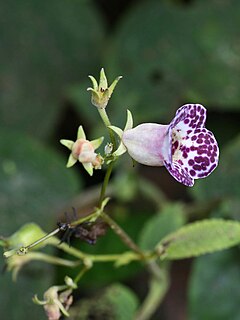The least gerbil is distributed mainly in South Sudan, southwestern Ethiopia, Kenya, and Tanzania.
The Agag gerbil is distributed mainly in southern Mauritania to northern Nigeria and Sudan. IUCN lists the junior synonyms Gerbillus cosensi and G. dalloni as critically endangered.

Gloxinia is a genus containing three species of tropical rhizomatous herbs in the flowering plant family Gesneriaceae. The species are primarily found in the Andes of South America, but Gloxinia perennis is also found in Central America and the West Indies, where it has probably escaped from cultivation.
Oecomys paricola, also known as the Brazilian oecomys, Brazilian arboreal rice rat, or South Amazonian arboreal rice rat, is a species of rodent in the genus Oecomys of family Cricetidae. It is found in central Brazil south of the Amazon, where it lives in lowland tropical rainforest.

Kemp's gerbil is a species of rodent. Mammal Species of the World considers G. kempi and G. gambianus to be synonyms, however the IUCN has assessed each taxon as were they different species.
The mud catshark or brown catshark is a species of catshark in the family Scyliorhinidae. It is found in Mozambique and Somalia. Its natural habitat is the open seas of the western Indian Ocean, from Mozambique to Somalia, between latitudes 13° N and 29° S, at depths between 340 and 765 m. It can grow up to 34 centimetres (13 in) long.

Tramea is a genus of dragonflies in the family Libellulidae, the skimmers and perchers. Species of Tramea are found in tropical and subtropical regions around the globe. They typically have colored bases to their otherwise translucent hindwings. In particular when they fly, this creates the impression of their carrying bags at the start of their abdomens. They are known commonly as saddlebags or saddlebags gliders.

Helicia is a genus of 110 species of trees and shrubs, constituting part of the plant family Proteaceae. They grow naturally in rainforests throughout tropical South and Southeast Asia, including India, Sri Lanka, Indochina, Peninsular Malaysia to New Guinea and as far south as New South Wales.
Monopyle ecuadorensis is a species of plant in the family Gesneriaceae. It is endemic to Ecuador. Its natural habitats are subtropical or tropical moist lowland forests and subtropical or tropical moist montane forests.

Monopyle is a genus of plants in the family Gesneriaceae.

Monopyle paniculata is a species of plant in the family Gesneriaceae. It is endemic to Ecuador. Its natural habitat is subtropical or tropical moist montane forests at altitudes of 500-1000m.
Monopyle sodiroana is a species of plant in the family Gesneriaceae. It is endemic to Ecuador. Its natural habitats are subtropical or tropical moist lowland forests and subtropical or tropical moist montane forests.

Stenoloba is an East Asian genus of moths of the family Noctuidae. The genus was described by Staudinger in 1892.

The World's 25 Most Endangered Primates is a list of highly endangered primate species selected and published by the International Union for Conservation of Nature (IUCN) Species Survival Commission (SSC) Primate Specialist Group (PSG), the International Primatological Society (IPS), Global Wildlife Conservation (GWC), and Bristol Zoological Society (BZS). The IUCN/SSC PSG worked with Conservation International (CI) to start the list in 2000, but in 2002, during the 19th Congress of the International Primatological Society, primatologists reviewed and debated the list, resulting in the 2002–2004 revision and the endorsement of the IPS. The publication was a joint project between the three conservation organizations until the 2012–2014 list when BZS was added as a publisher. The 2018–2020 list was the first time Conservation International was not among the publishers, replaced instead by GWC. The list has been revised every two years following the biannual Congress of the IPS. Starting with the 2004–2006 report, the title changed to "Primates in Peril: The World's 25 Most Endangered Primates". That same year, the list began to provide information about each species, including their conservation status and the threats they face in the wild. The species text is written in collaboration with experts from the field, with 60 people contributing to the 2006–2008 report and 85 people contributing to the 2008–2010 report. The 2004–2006 and 2006–2008 reports were published in the IUCN/SSC PSG journal Primate Conservation,, since then they have been published as independent publications.

Stenoloba viridicollar is a moth of the family Noctuidae. It is found in southwestern China (Sichuan)

Tramea stenoloba, the narrow-lobed glider, is a species of dragonfly in the Libellulidae family. It is found in the Cocos Islands, Lesser Sunda Islands, Java Sea and Australia.

Tramea eurybia is a species of dragonfly in the family Libellulidae, known as the dune glider. It inhabits still waters on the Andaman Islands, Sumatra, Sulawesi, the Maluku Islands, New Guinea and Fiji; and can be found at dune lakes in eastern Australia. It is a medium-sized dragonfly with red, brown and black markings and a distinctive dark patch at the base of the hindwing.
Synaphea stenoloba is a shrub endemic to Western Australia.











